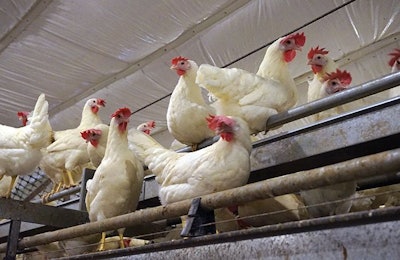
Approximately 26% of the U.S. hen population is currently housed in a cage-free facility. To meet the projected demand more than 70% of the U.S. laying hen flock will need to be cage-free by 2026 and the industry would need to invest roughly US$6.5 billion. Cal-Maine Foods has invested $405 million since 2008 to expand its cage-free production.
"We believe this cage-free conversion is a big opportunity, the egg industry is very fragmented, mostly family businesses, there is generational turnover in these families, and the capital requirements to convert to cage-free are a huge commitment. So we think there are great opportunities that lie ahead," said Dolph Baker, chief executive officer and chairman of the Board of Directors with Cal-Maine Foods during the Bank of America 2021 Consumer & Retail Technology Conference on March 10.
During the conference, Cal-Maine addressed its financial standings and what it means for company expansion and plans.
"We believe we have significant growth opportunities, organically as well as acquisitions. As Dolph said, we participate in a highly fragmented market. We have a very strong balance sheet that can support these growth initiatives," said Max Bowman, vice president, chief financial officer, treasurer, secretary and director with Cal-Maine foods during the same call.
The approximate $6.5 billion for the industry to convert seems rather daunting to some but legislation may force the issue. "Historically, and I believe going forward, the producer will comply with whatever federal, state and local mandates are out there for production methods. There are seven states with a couple more right behind them that have said all cage-free production and sales within those states. Dolph said those states represent, I think, about 23% of the country's consumers. So, there is a lot of demand for cage-free eggs out there," said Bowman.
Cal-Maine as a producer, first and foremost, tries to produce eggs that its customers want to buy. "We have to match our production to their demand. We believe strongly in offering them the choices they want to have. We have also said we have spent over $400 million in preparing for the cage-free markets but ultimately we have to look at our customer base," Bowman said.
The company's customer base is largely in the southeast, in Texas and Florida, and frankly, other states where there hasn't been a big move or mandate towards cage-free, Bowman explained. The company plans to continue to monitor those things and position itself to be ready for customers' demands.
"We think we are in as good of a position as anybody, I always say I like the hand we were dealt with, we've been able to manage the cage-free expansion we've done to this point basically financed out of cash flow. We still have a healthy cash balance and an untapped credit facility, and we are a public company with access to the capital and debt market. While I am not suggesting that we could take on this whole $6.5 billion that is estimated, we certainly feel we can do our part and see it as somewhat of an opportunity to further grow our business," Bowman said.
He did note that he believes the $6.5 billion needed, along with the number of hens that would have to be in production seems very ambitious.
New cage-free facility in Kentucky
The Cal-Maine Foods Board of Directors approved a $40.1 million capital project to expand the company's cage-free egg production at its Guthrie, Kentucky, production facility.
The project will include related site work and the additional infrastructure to convert existing conventional capacity to house approximately 1.5 million cage-free hens and 300,000 pullets. Construction will commence immediately, with initial conversions expected in early 2021. The first pullet placements are planned to be made by summer 2021 and the first layer house is expected to be finished by fall 2021. Project completion is expected by late 2022.
The company plans to fund the project through a combination of available cash on hand, investments, and operating cash flow.
Bowman explained that he believes they're doing this project at a pace that will align with Cal-Maine's customer demand.
Pasture-raised eggs
Cal-Maine does not currently play in the pasture-raised egg market. "There has been a lot of interest (in this area), there is a demand for pasture-raised eggs, although it is a small part of the market (4% to 5% he noted), I commented earlier that we play in 96% of the space at retail. We have not been aggressive on the pasture side, but we are listening to our customers and we are here to provide them with what they ask for," said Baker.
He noted that the pasture-raised sector is interesting and has a lot of consumers and producer's attention. "We will see how it plays out, but I would say there is probably going to be more competition in that space than we have had in the past," Baker concluded.

















